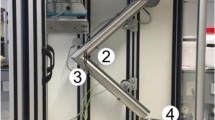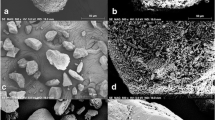Abstract
Abstract
To investigate the influence of storage relative humidity (RH) on the aerosolisation efficiency and tribo-electrification of carrier based dry powder inhaler (DPI) formulations using the next generation impactor (NGI) in vitro methodology and the electrostatic low pressure impactor (ELPI). Micronised salbutamol (d 0.5 1.48 ± 0.03 μm) was blended with 63–90 μm sieve fractioned α-lactose monohydrate carrier and stored at a range of humidities (0–84% RH). The aerosolisation efficiency after storage for 24 h periods was investigated using the NGI. The same experiment was conducted using the ELPI, with corona charger switched off, to measure the net charge vs. mass deposition profile. Significant variations in the aerosolisation efficiency of the formulation were observed with respect to storage RH. In general, the fine particle fraction aerosol performance measured by NGI and ELPI (fraction with mass median aerodynamic diameter <4.46 and 4.04 μm, respectively) followed a positive parabola with aerosol performance increasing over the range 0–60% RH before decreasing >60% RH. Analysis of the ELPI charge data suggested that the micronised salbutamol sulphate had an electronegative charge when aerosolised from lactose based carriers, which was most electronegative at low RH. Increased storage RH resulted in a reduction in net charge to mass ratio with the greatest reduction at RH >60%. The aerosol performance of this binary system is dependent on both electrostatic and capillary forces. The use of the ELPI allows a degree of insight into how these forces affect formulation performances after storage at different RH.






Similar content being viewed by others
References
I. J. Smith and M. Parry-Billings. The inhalers of the future? A review of dry powder devices on the market today. Pulm. Pharmacol. Ther. 16:79–95 (2003).
M. S. Coates, D. F. Fletcher, H. K. Chan, and J. A. Raper. Effect of design on the performance of a dry powder inhaler using computational fluid dynamics. Part 1: grid structure and mouthpiece length. J. Pharm. Sci. 93:2863–2876 (2004).
W. C. Hinds. Aerosol Technology. Wiley, New York, 1999.
R. N. Jashnani and P. R. Byron. Dry powder aerosol generation in different environments: performance comparisons of albuterol, albuterol sulfate, albuterol adipate and albuterol stearate1. Int. J. Pharm. 130:13–24 (1996).
R. N. Jashnani, P. R. Byron, and R. N. Dalby. Testing of dry powder aerosol formulations in different environmental-conditions. Int. J. Pharm. 113:123–130 (1995).
P. M. Young, R. Price, M. J. Tobyn, M. Buttrum, and F. Dey. Effect of humidity on aerosolization of micronized drugs. Drug Dev. Ind. Pharm. 29:959–966 (2003).
P. M. Young and R. Price. The influence of humidity on the aerosolisation of micronised and SEDS produced salbutamol sulphate. Eur. J. Pharm. Sci. 22:235–240 (2004).
K. Iida, Y. Hayakawa, H. Okamoto, K. Danjo, and H. Luenberger. Influence of storage humidity on the in vitro inhalation properties of salbutamol sulfate dry powder with surface covered lactose carrier. Chem. Pharm. Bull. 52:444–446 (2004).
A. Voss and W. H. Finlay. Deagglomeration of dry powder pharmaceutical aerosols 1. Int. J. Pharm. 248:39–50 (2002).
L. Maggi, R. Bruni, and U. Conte. Influence of the moisture on the performance of a new dry powder inhaler30. Int. J. Pharm. 177:83–91 (1999).
P. M. Young, M. J. Tobyn, R. Price, M. Buttrum, and F. Dey. The use of colloid probe microscopy to predict aerosolization performance in dry powder inhalers: AFM and in vitro correlation. J. Pharm. Sci. (2006).
P. M. Young, R. Price, M. J. Tobyn, M. Buttrum, and F. Dey. The influence of relative humidity on the cohesion properties of micronized drugs used in inhalation therapy. J. Pharm. Sci. 93:753–761 (2004).
P. M. Young, R. Price, M. J. Tobyn, M. Buttrum, and F. Dey. Investigation into the effect of humidity on drug–drug interactions using the atomic force microscope. J. Pharm. Sci. 92:815–822 (2003).
V. Berard, E. Lesniewska, C. Andres, D. Pertuy, C. Laroche, and Y. Pourcelot. Dry powder inhaler: influence of humidity on topology and adhesion studied by AFM7. Int. J. Pharm. 232:213–224 (2002).
J. C. Hooton, C. S. German, S. Allen, M. C. Davies, C. J. Roberts, S. J. B. Tendler, and P. M. Williams. An atomic force microscopy study of the effect of nanoscale contact geometry and surface chemistry on the adhesion of pharmaceutical particles 1. Pharm. Res. 21:953–961 (2004).
C. G. Peng, A. H. L. Chow, and C. K. Chan. Study of the hygroscopic properties of selected pharmaceutical aerosols using single particle levitation. Pharm. Res. 17:1104–1109 (2000).
F. Podczeck, J. M. Newton, and M. B. James. Variations in the adhesion force between a drug and carrier particles as a result of changes in the relative humidity of the air. Int. J. Pharm. 149:151–160 (1997).
F. Podczeck, J. M. Newton, and M. B. James. The influence of constant and changing relative humidity of the air on the autoadhesion force between pharmaceutical powder particles. Int. J. Pharm. 145:221–229 (1996).
A. Elajnaf, P. A. Carter, and G. Rowley. Electrostatic characterisation of inhaled powders: effect of contact surface and relative humidity. Eur. J. Pharm. Sci. 29:375–384 (2006).
P. R. Byron, J. Peart, and J. N. Staniforth. Aerosol electrostatics. 1. Properties of fine powders before and after aerosolization by dry powder inhalers. Pharm. Res. 14:698–705 (1997).
V. A. Philip, R. C. Mehta, M. K. Mazumder, and P. P. Deluca. Effect of surface treatment on the respirable fractions of PLGA microspheres formulated for dry powder inhalers. Int. J. Pharm. 151:165–174 (1997).
G. Rowley and L. A. Mackin. The effect of moisture sorption on electrostatic charging of selected pharmaceutical excipient powders. Powder Technol. 135:50–58 (2003).
G. Rowley. Quantifying electrostatic interactions in pharmaceutical solid systems. Int. J. Pharm. 227:47–55 (2001).
F. S. Bennett, P. A. Carter, G. Rowley, and Y. Dandiker. Modification of electrostatic charge on inhaled carrier lactose particles by addition of fine particles. Drug Dev. Ind. Pharm. 25:99–103 (1999).
M. Murtomaa, V. Mellin, P. Harjunen, T. Lankinen, E. Laine, and V. P. Lehto. Effect of particle morphology on the triboelectrification in dry powder inhalers. Int. J. Pharm. 282:107–114 (2004).
M. Murtomaa, S. Strengell, E. Laine, and A. Bailey. Measurement of electrostatic charge of an aerosol using a grid-probe. J. Electrost. 58:197–207 (2003).
M. Dawson, P. Burnell, W. Balachandran, and S. Sivathasan. A novel bipolar charge measurement system for characterising aerosols. In R. Dalby, P. R. Byron, J. Peart, and S. Farr (eds.), Respiratory Drug Delivery VIII, 2002, pp. 443–445.
W. Glover and H. K. Chan. Electrostatic charge characterization of pharmaceutical aerosols using electrical low-pressure impaction (ELPI). J. Aerosol Sci. 35:755–764 (2004).
G. M. Richardson and R. S. Malthus. Salts for the static control of humidity at relatively low levels. J. Appl. Chem. 557–567 (1955).
M. Marjamaki, J. Keskinen, D. R. Chen, and D. Y. H. Pui. Performance evaluation of the electrical low-pressure impactor (ELPI)4. J. Aerosol Sci. 31:249–261 (2000).
C. H. Giles, T. H. Macewan, S. N. Nakhwa, and D. Smith. Studies in Adsorption. Part XI. A System of Classification of Solution Adsorption Isotherms, and Its Use in Diagnosis of Adsorption Mechanisms and in Measurement of Specific Surface Areas of Solids. J. Chem. Soc. 3973–3993 (1960).
G. Buckton and P. Darcy. The use of gravimetric studies to assess the degree of crystallinity of predominantly crystalline powders. Int. J. Pharm. 123:265–271 (1995).
P. M. Young, S. Edge, D. Traini, M. D. Jones, R. Price, D. El-Sabawi, C. Urry, and C. Smith. The influence of dose on the performance of dry powder inhalation systems 1. Int. J. Pharm. 296:26–33 (2005).
D. Traini, P. M. Young, M. D. Jones, S. Edge, and R. Price. Comparative study of erythritol and lactose monohydrate as carriers for inhalation: atomic force microscopy and in vitro correlation. Eur. J. Pharm. Sci. 27:243–251 (2006).
H. Steckel, P. Markefka, H. teWierik, and R. Kammelar. Functionality testing of inhalation grade lactose 12. Eur. J. Pharm. Biopharm. 57:495–505 (2004).
T. Srichana, G. P. Martin, and C. Marriott. Dry powder inhalers: the influence of device resistance and powder formulation on drug and lactose deposition in vitro. Eur. J. Pharm. Sci. 7:73–80 (1998).
Author information
Authors and Affiliations
Corresponding author
Rights and permissions
About this article
Cite this article
Young, P.M., Sung, A., Traini, D. et al. Influence of Humidity on the Electrostatic Charge and Aerosol Performance of Dry Powder Inhaler Carrier based Systems. Pharm Res 24, 963–970 (2007). https://doi.org/10.1007/s11095-006-9218-8
Received:
Accepted:
Published:
Issue Date:
DOI: https://doi.org/10.1007/s11095-006-9218-8




